Corporate Social Responsibility: Sustainability, Business, and Ethics
VerifiedAdded on 2023/05/28
|5
|1225
|143
Report
AI Summary
This report explores the key drivers of Corporate Social Responsibility (CSR) in the age of responsibility, focusing on sustainability, business ethics, and environmental impact. It examines Wayne Visser's perspective on why companies are taking sustainability more seriously, highlighting the consequences for those who ignore it. The report discusses how human behavior and behavioral economics, particularly nudging, can promote sustainability among consumers. It analyzes Walmart as an example of a company worth emulating for its sustainability efforts and addresses the challenges in introducing sustainable products and services. Furthermore, the report defines responsiveness in the age of responsibility, providing examples and discussing the trade-off between responsiveness and scalability. Finally, it explains the concept of glocality and its application to business, emphasizing the benefits of thinking globally and acting locally to increase market share, promote ethical practices, and expand business ideas.
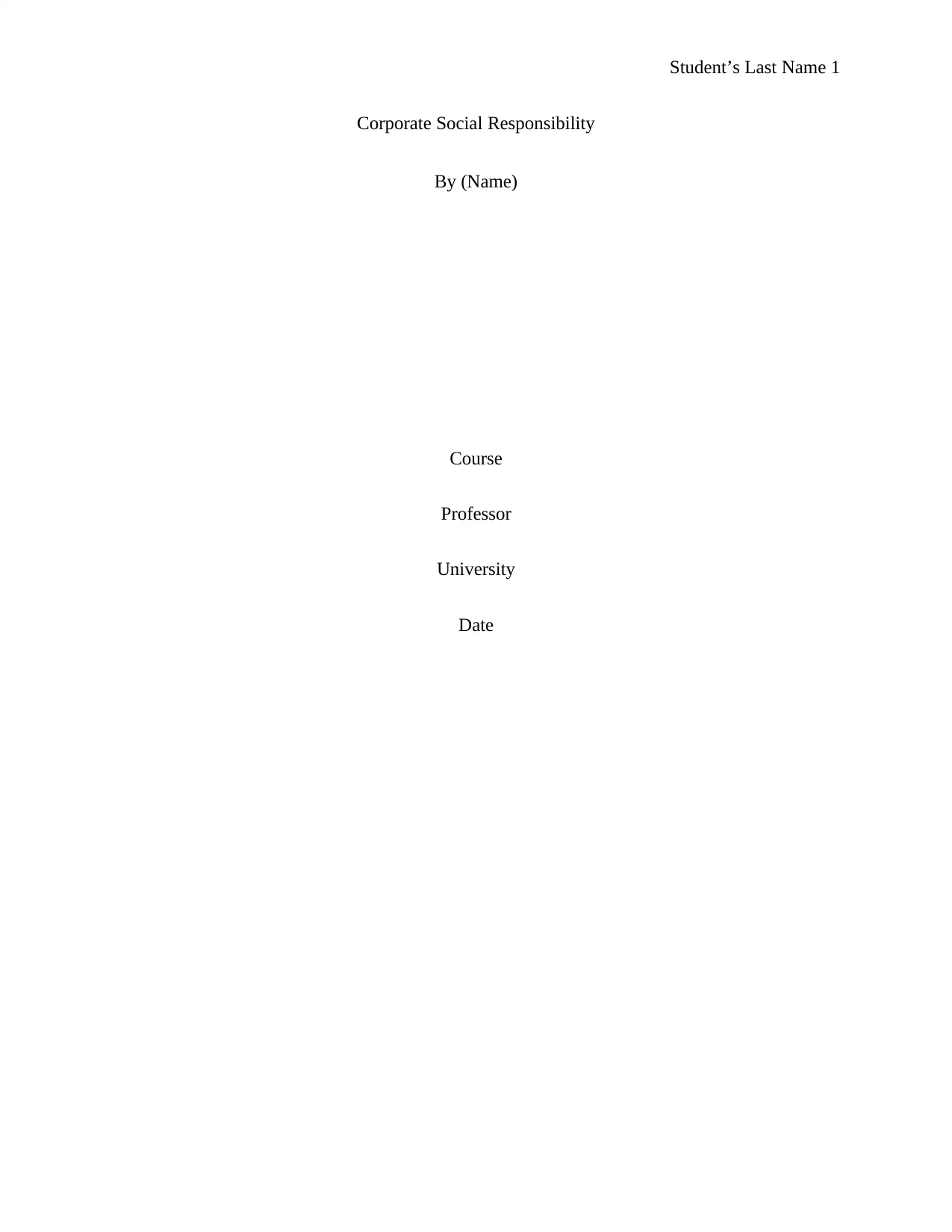
Student’s Last Name 1
Corporate Social Responsibility
By (Name)
Course
Professor
University
Date
Corporate Social Responsibility
By (Name)
Course
Professor
University
Date
Paraphrase This Document
Need a fresh take? Get an instant paraphrase of this document with our AI Paraphraser
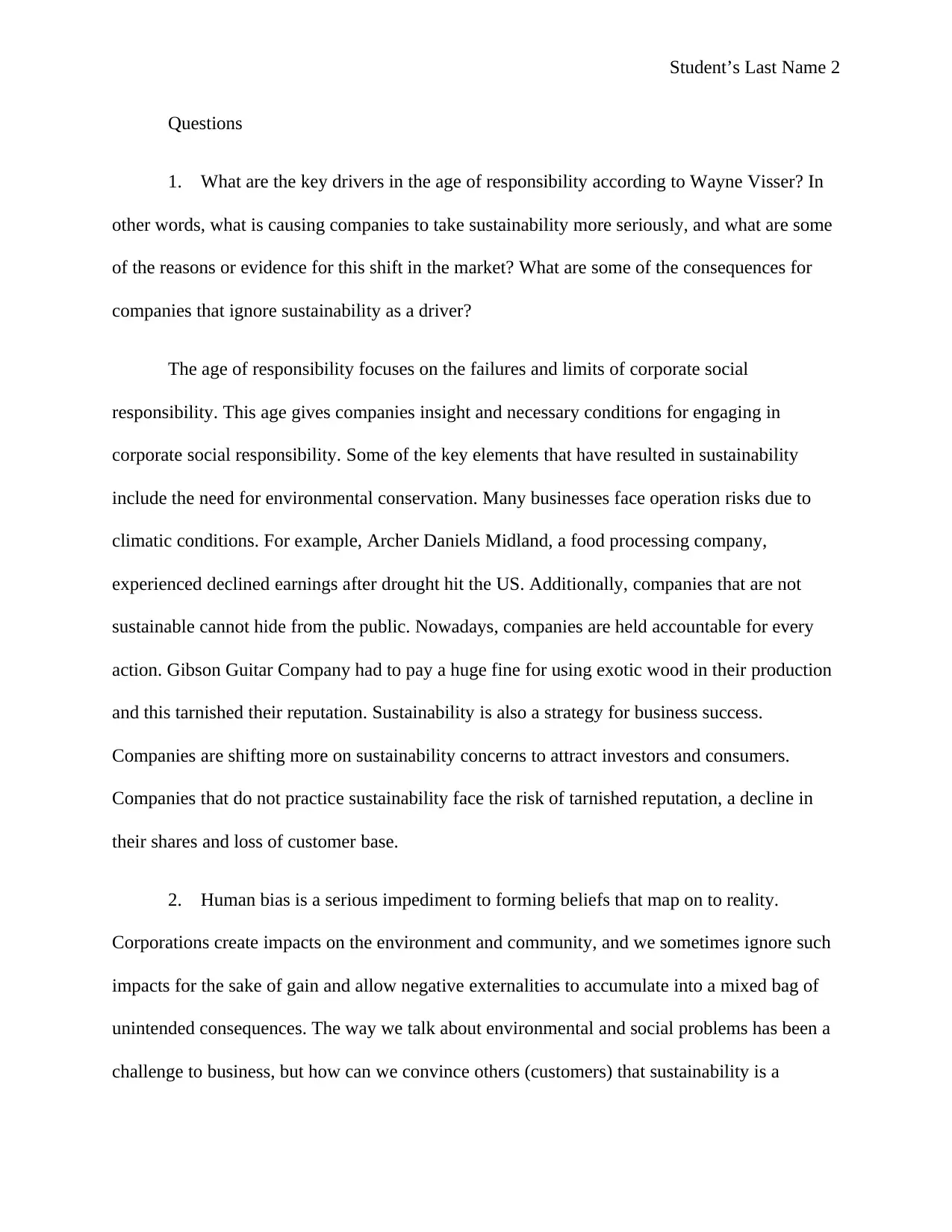
Student’s Last Name 2
Questions
1. What are the key drivers in the age of responsibility according to Wayne Visser? In
other words, what is causing companies to take sustainability more seriously, and what are some
of the reasons or evidence for this shift in the market? What are some of the consequences for
companies that ignore sustainability as a driver?
The age of responsibility focuses on the failures and limits of corporate social
responsibility. This age gives companies insight and necessary conditions for engaging in
corporate social responsibility. Some of the key elements that have resulted in sustainability
include the need for environmental conservation. Many businesses face operation risks due to
climatic conditions. For example, Archer Daniels Midland, a food processing company,
experienced declined earnings after drought hit the US. Additionally, companies that are not
sustainable cannot hide from the public. Nowadays, companies are held accountable for every
action. Gibson Guitar Company had to pay a huge fine for using exotic wood in their production
and this tarnished their reputation. Sustainability is also a strategy for business success.
Companies are shifting more on sustainability concerns to attract investors and consumers.
Companies that do not practice sustainability face the risk of tarnished reputation, a decline in
their shares and loss of customer base.
2. Human bias is a serious impediment to forming beliefs that map on to reality.
Corporations create impacts on the environment and community, and we sometimes ignore such
impacts for the sake of gain and allow negative externalities to accumulate into a mixed bag of
unintended consequences. The way we talk about environmental and social problems has been a
challenge to business, but how can we convince others (customers) that sustainability is a
Questions
1. What are the key drivers in the age of responsibility according to Wayne Visser? In
other words, what is causing companies to take sustainability more seriously, and what are some
of the reasons or evidence for this shift in the market? What are some of the consequences for
companies that ignore sustainability as a driver?
The age of responsibility focuses on the failures and limits of corporate social
responsibility. This age gives companies insight and necessary conditions for engaging in
corporate social responsibility. Some of the key elements that have resulted in sustainability
include the need for environmental conservation. Many businesses face operation risks due to
climatic conditions. For example, Archer Daniels Midland, a food processing company,
experienced declined earnings after drought hit the US. Additionally, companies that are not
sustainable cannot hide from the public. Nowadays, companies are held accountable for every
action. Gibson Guitar Company had to pay a huge fine for using exotic wood in their production
and this tarnished their reputation. Sustainability is also a strategy for business success.
Companies are shifting more on sustainability concerns to attract investors and consumers.
Companies that do not practice sustainability face the risk of tarnished reputation, a decline in
their shares and loss of customer base.
2. Human bias is a serious impediment to forming beliefs that map on to reality.
Corporations create impacts on the environment and community, and we sometimes ignore such
impacts for the sake of gain and allow negative externalities to accumulate into a mixed bag of
unintended consequences. The way we talk about environmental and social problems has been a
challenge to business, but how can we convince others (customers) that sustainability is a
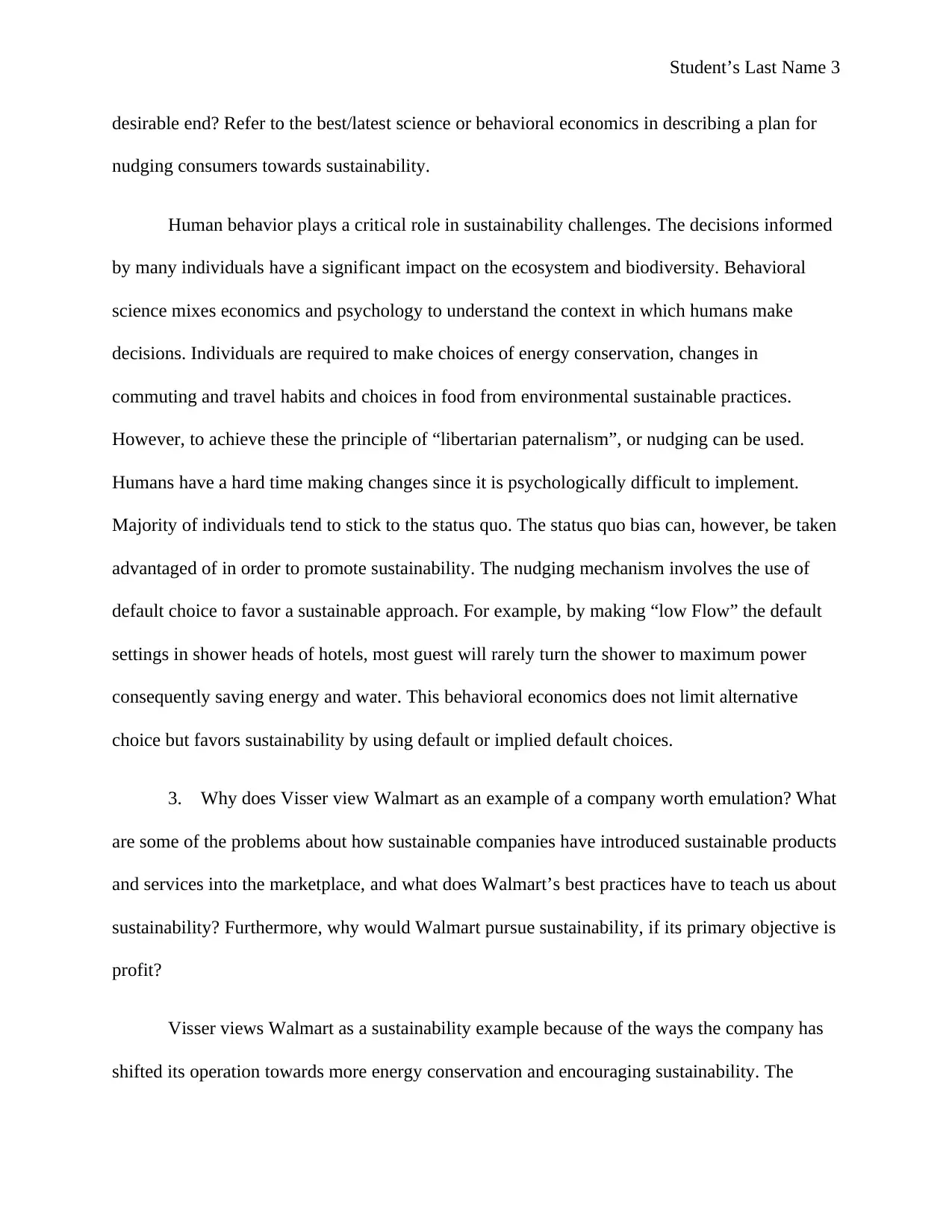
Student’s Last Name 3
desirable end? Refer to the best/latest science or behavioral economics in describing a plan for
nudging consumers towards sustainability.
Human behavior plays a critical role in sustainability challenges. The decisions informed
by many individuals have a significant impact on the ecosystem and biodiversity. Behavioral
science mixes economics and psychology to understand the context in which humans make
decisions. Individuals are required to make choices of energy conservation, changes in
commuting and travel habits and choices in food from environmental sustainable practices.
However, to achieve these the principle of “libertarian paternalism”, or nudging can be used.
Humans have a hard time making changes since it is psychologically difficult to implement.
Majority of individuals tend to stick to the status quo. The status quo bias can, however, be taken
advantaged of in order to promote sustainability. The nudging mechanism involves the use of
default choice to favor a sustainable approach. For example, by making “low Flow” the default
settings in shower heads of hotels, most guest will rarely turn the shower to maximum power
consequently saving energy and water. This behavioral economics does not limit alternative
choice but favors sustainability by using default or implied default choices.
3. Why does Visser view Walmart as an example of a company worth emulation? What
are some of the problems about how sustainable companies have introduced sustainable products
and services into the marketplace, and what does Walmart’s best practices have to teach us about
sustainability? Furthermore, why would Walmart pursue sustainability, if its primary objective is
profit?
Visser views Walmart as a sustainability example because of the ways the company has
shifted its operation towards more energy conservation and encouraging sustainability. The
desirable end? Refer to the best/latest science or behavioral economics in describing a plan for
nudging consumers towards sustainability.
Human behavior plays a critical role in sustainability challenges. The decisions informed
by many individuals have a significant impact on the ecosystem and biodiversity. Behavioral
science mixes economics and psychology to understand the context in which humans make
decisions. Individuals are required to make choices of energy conservation, changes in
commuting and travel habits and choices in food from environmental sustainable practices.
However, to achieve these the principle of “libertarian paternalism”, or nudging can be used.
Humans have a hard time making changes since it is psychologically difficult to implement.
Majority of individuals tend to stick to the status quo. The status quo bias can, however, be taken
advantaged of in order to promote sustainability. The nudging mechanism involves the use of
default choice to favor a sustainable approach. For example, by making “low Flow” the default
settings in shower heads of hotels, most guest will rarely turn the shower to maximum power
consequently saving energy and water. This behavioral economics does not limit alternative
choice but favors sustainability by using default or implied default choices.
3. Why does Visser view Walmart as an example of a company worth emulation? What
are some of the problems about how sustainable companies have introduced sustainable products
and services into the marketplace, and what does Walmart’s best practices have to teach us about
sustainability? Furthermore, why would Walmart pursue sustainability, if its primary objective is
profit?
Visser views Walmart as a sustainability example because of the ways the company has
shifted its operation towards more energy conservation and encouraging sustainability. The
⊘ This is a preview!⊘
Do you want full access?
Subscribe today to unlock all pages.

Trusted by 1+ million students worldwide
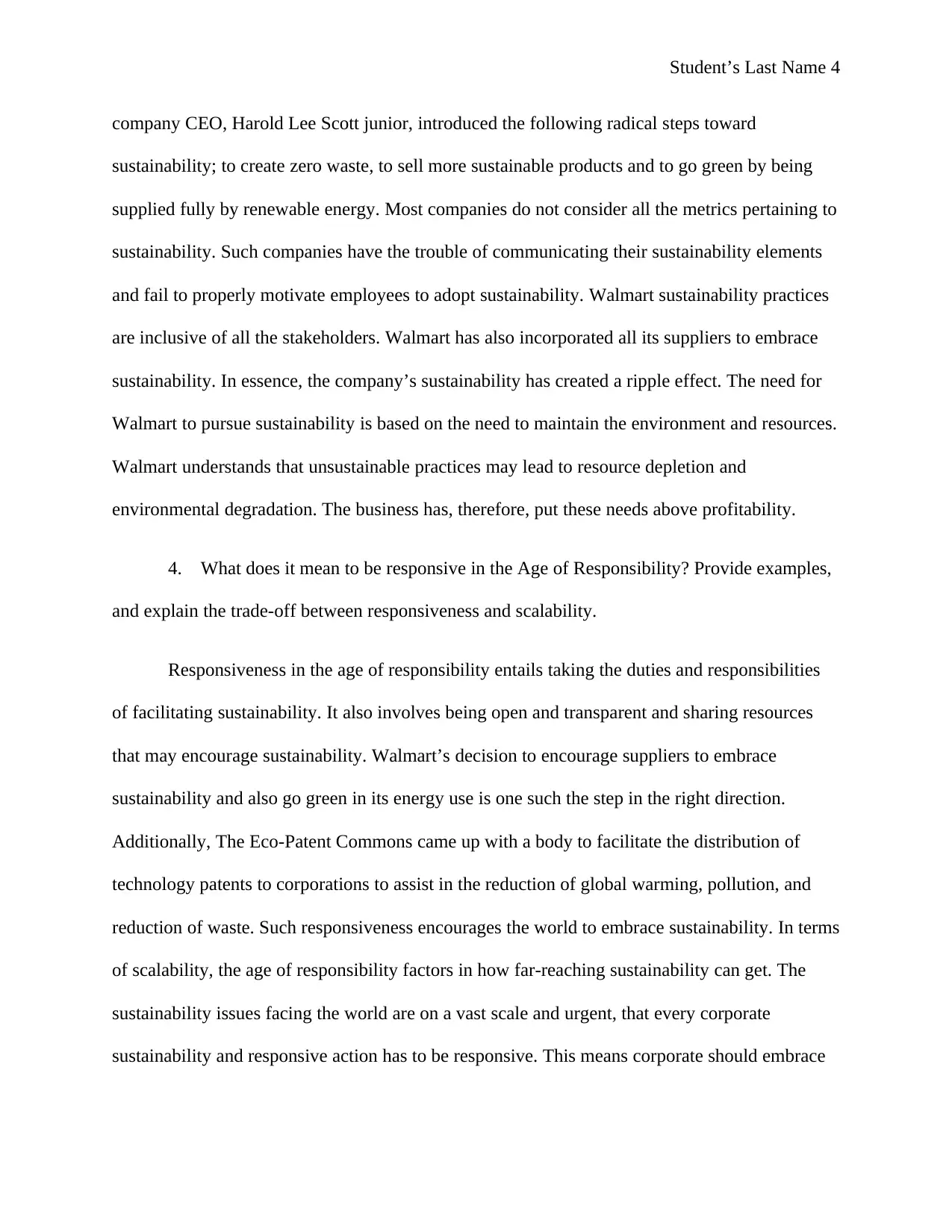
Student’s Last Name 4
company CEO, Harold Lee Scott junior, introduced the following radical steps toward
sustainability; to create zero waste, to sell more sustainable products and to go green by being
supplied fully by renewable energy. Most companies do not consider all the metrics pertaining to
sustainability. Such companies have the trouble of communicating their sustainability elements
and fail to properly motivate employees to adopt sustainability. Walmart sustainability practices
are inclusive of all the stakeholders. Walmart has also incorporated all its suppliers to embrace
sustainability. In essence, the company’s sustainability has created a ripple effect. The need for
Walmart to pursue sustainability is based on the need to maintain the environment and resources.
Walmart understands that unsustainable practices may lead to resource depletion and
environmental degradation. The business has, therefore, put these needs above profitability.
4. What does it mean to be responsive in the Age of Responsibility? Provide examples,
and explain the trade-off between responsiveness and scalability.
Responsiveness in the age of responsibility entails taking the duties and responsibilities
of facilitating sustainability. It also involves being open and transparent and sharing resources
that may encourage sustainability. Walmart’s decision to encourage suppliers to embrace
sustainability and also go green in its energy use is one such the step in the right direction.
Additionally, The Eco-Patent Commons came up with a body to facilitate the distribution of
technology patents to corporations to assist in the reduction of global warming, pollution, and
reduction of waste. Such responsiveness encourages the world to embrace sustainability. In terms
of scalability, the age of responsibility factors in how far-reaching sustainability can get. The
sustainability issues facing the world are on a vast scale and urgent, that every corporate
sustainability and responsive action has to be responsive. This means corporate should embrace
company CEO, Harold Lee Scott junior, introduced the following radical steps toward
sustainability; to create zero waste, to sell more sustainable products and to go green by being
supplied fully by renewable energy. Most companies do not consider all the metrics pertaining to
sustainability. Such companies have the trouble of communicating their sustainability elements
and fail to properly motivate employees to adopt sustainability. Walmart sustainability practices
are inclusive of all the stakeholders. Walmart has also incorporated all its suppliers to embrace
sustainability. In essence, the company’s sustainability has created a ripple effect. The need for
Walmart to pursue sustainability is based on the need to maintain the environment and resources.
Walmart understands that unsustainable practices may lead to resource depletion and
environmental degradation. The business has, therefore, put these needs above profitability.
4. What does it mean to be responsive in the Age of Responsibility? Provide examples,
and explain the trade-off between responsiveness and scalability.
Responsiveness in the age of responsibility entails taking the duties and responsibilities
of facilitating sustainability. It also involves being open and transparent and sharing resources
that may encourage sustainability. Walmart’s decision to encourage suppliers to embrace
sustainability and also go green in its energy use is one such the step in the right direction.
Additionally, The Eco-Patent Commons came up with a body to facilitate the distribution of
technology patents to corporations to assist in the reduction of global warming, pollution, and
reduction of waste. Such responsiveness encourages the world to embrace sustainability. In terms
of scalability, the age of responsibility factors in how far-reaching sustainability can get. The
sustainability issues facing the world are on a vast scale and urgent, that every corporate
sustainability and responsive action has to be responsive. This means corporate should embrace
Paraphrase This Document
Need a fresh take? Get an instant paraphrase of this document with our AI Paraphraser
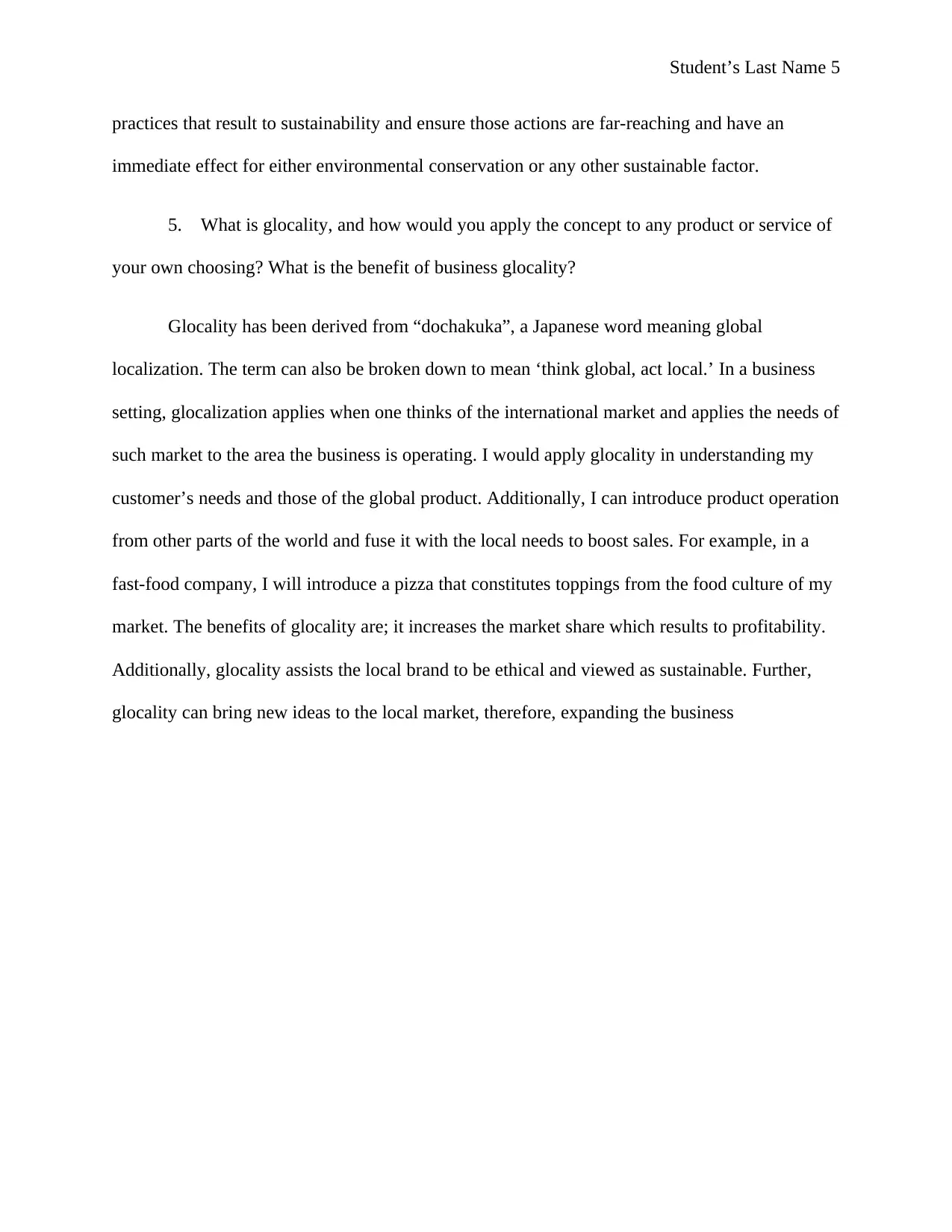
Student’s Last Name 5
practices that result to sustainability and ensure those actions are far-reaching and have an
immediate effect for either environmental conservation or any other sustainable factor.
5. What is glocality, and how would you apply the concept to any product or service of
your own choosing? What is the benefit of business glocality?
Glocality has been derived from “dochakuka”, a Japanese word meaning global
localization. The term can also be broken down to mean ‘think global, act local.’ In a business
setting, glocalization applies when one thinks of the international market and applies the needs of
such market to the area the business is operating. I would apply glocality in understanding my
customer’s needs and those of the global product. Additionally, I can introduce product operation
from other parts of the world and fuse it with the local needs to boost sales. For example, in a
fast-food company, I will introduce a pizza that constitutes toppings from the food culture of my
market. The benefits of glocality are; it increases the market share which results to profitability.
Additionally, glocality assists the local brand to be ethical and viewed as sustainable. Further,
glocality can bring new ideas to the local market, therefore, expanding the business
practices that result to sustainability and ensure those actions are far-reaching and have an
immediate effect for either environmental conservation or any other sustainable factor.
5. What is glocality, and how would you apply the concept to any product or service of
your own choosing? What is the benefit of business glocality?
Glocality has been derived from “dochakuka”, a Japanese word meaning global
localization. The term can also be broken down to mean ‘think global, act local.’ In a business
setting, glocalization applies when one thinks of the international market and applies the needs of
such market to the area the business is operating. I would apply glocality in understanding my
customer’s needs and those of the global product. Additionally, I can introduce product operation
from other parts of the world and fuse it with the local needs to boost sales. For example, in a
fast-food company, I will introduce a pizza that constitutes toppings from the food culture of my
market. The benefits of glocality are; it increases the market share which results to profitability.
Additionally, glocality assists the local brand to be ethical and viewed as sustainable. Further,
glocality can bring new ideas to the local market, therefore, expanding the business
1 out of 5
Your All-in-One AI-Powered Toolkit for Academic Success.
+13062052269
info@desklib.com
Available 24*7 on WhatsApp / Email
![[object Object]](/_next/static/media/star-bottom.7253800d.svg)
Unlock your academic potential
Copyright © 2020–2025 A2Z Services. All Rights Reserved. Developed and managed by ZUCOL.

